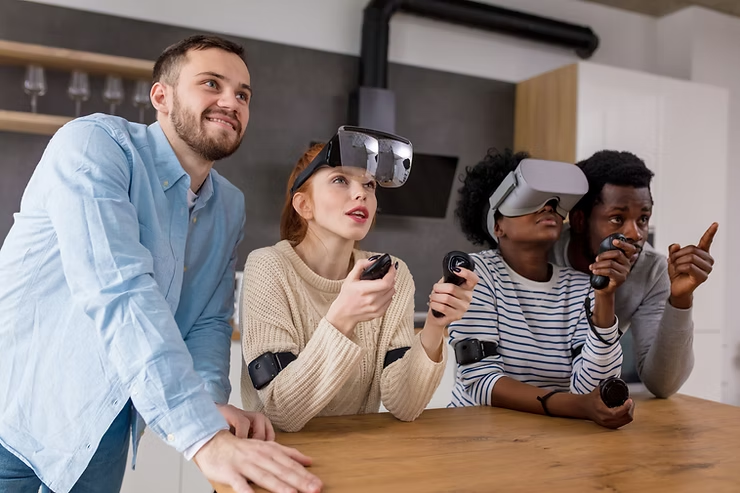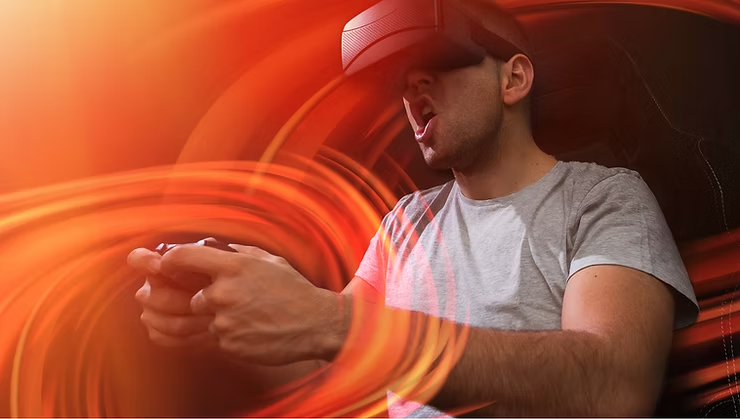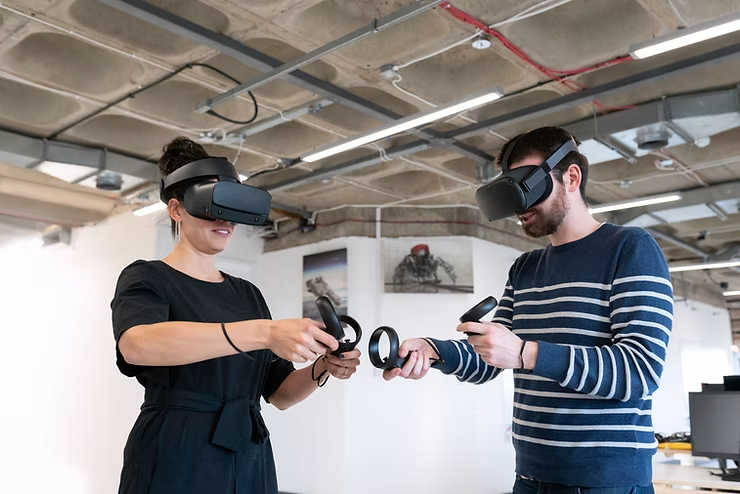Feb 2, 2022
4 min read
What do AR, VR and Blended Reality mean for e-learning?
Updated: Jun 2, 2022
In recent years, we have seen major changes in the field of technology. New technologies such as blockchain, virtual reality (VR), artificial intelligence (AI), augmented reality (AR) and mixed reality are increasingly used by larger organizations.

AR, VR & E-Learning: What's the Future?
It is therefore necessary to examine and investigate whether this technology can also be used for e-learning. In the area of AR and VR, we are already seeing some developments.
To improve readability, we spend the rest of this blog article talking about about VR, but we also refer to AR and Mixed Reality.
For students, we see possibilities to interact in a virtual environment with different characters and items. For the student, the experience is more realistic and, compared to traditional online training, such as with the use of video and / or content, also more interesting.
What examples and developments do we see in the e-learning market and should companies prepare for their use?
Examples of how VR is already being used in e-learning
The use of VR in the e-learning market is nothing new. In North America in particular, we are already seeing some applications at large companies.
- Google offers free VR headsets to schools.
- NASA uses VR to train astronauts and prepare them for new missions.
- The US Army uses VR to train soldiers in a realistic environment.
- Our partner Sping has made a training course for Perfetti van Melle for the Risk Assessment department, where the trainee walks around a virtual factory in Shanghai. By going through this training, a visitor to the factory is already familiar with the safety procedures prior to a visit.
How are these kinds of large companies using VR for the training?
What are the advantages of a VR training?
Realistic
VR offers the ability to provide a realistic picture of the practice. By linking theory to this 'practical experience', the training becomes less abstract. VR training makes it possible to realistically train for dangerous exercises.
Personal
Students are better able to recognize themselves in these training courses because it is less abstract. Personalized learning environments offer the ability to create content that best suits the learner.
More involvement
Students are more involved and therefore more motivated. Students are better focused during the training. They are not distracted by external factors such as social media.
Cost-saving
VR training courses make it possible to save costs.
- In addition to knowledge skills, it is also possible to train the physical skills of the student. This applies particularly to dangerous simulation training.
But if there are so many advantages to VR, how come no critical mass has been created? Which factors slow down the implementation of VR in e-learning?
Disadvantages of VR in e-learning
Scalability and range
The use of VR limits scalability. For every student, there must be a VR-1 headset available. This is, compared to e-learning, different because the scalability is a big advantage.
Finances
In order to be able to use VR for e-learning, it is necessary to make more budget available than with traditional e-learning training courses. At the moment, only the early adopters use VR because the hardware that is needed is very expensive. We are convinced that in the future, the hardware will become more affordable and more companies will use VR in e-learning.
Hardware criteria
When using VR, it's not only a relatively expensive headset is used. It also requires the use of other hardware, such as a fast computer. The hardware criteria are therefore very high and the need for user-friendly hardware is great.
Physical
With the use of VR, it's not just the glasses that are used. There are also other accessories that restrict freedom of movement. The use of VR compared to traditional e-learning is limited. Course participants want the ability to learn where and when they want. As the VR headsets become more ergonomic and compact, they will be used more often.
Another physical element, which can be an objection, is the possibility of getting nauseous while following VR training. This can occur because there is a delay on the screen, which can make a trainee nauseous.
Conclusion
Although modern technology such as VR is still fairly new, it already has a lot to offer in the field of e-learning. In the future it will certainly be used more and more often.
How can we help you?
Are you curious about developments in the field of new technology such as VR, AR or e-learning? Would you like to see if this technology can be included in your training or academy? With our expertise, we can advise you. We do this by drawing up a quick report. This includes a number of elements, such as:
- Insight into the current training environment/LMS
- Insight in the type of student (student persona)
- Insight into the student's journey (student journey)
- Insight into the objectives (KPIs)
- Advice (content) on integration with VR/AR
- Advice on technical integration
About Maxcademy
Our company provides customized e-learning for organizations. We have a great deal of experience in transferring classroom training content to online and ensure that all the possibilities of e-learning are used optimally. We provide the student with an experience that is pleasant to follow by avoiding long pieces of text and making extensive use of video and interactive content. In doing so, we avoid unnecessary gimmicks that add little to the learning experience. Our goal is to build a training course that is not only fun to follow, but also easy to maintain due to a modular structure.
Want to learn more? Then contact us or take a look at our Inspiration page.
317 views0 comments
Explore Our Latest Insights
Stay updated with our latest articles and industry trends.
The impact of e-learning
Discover how e-learning is transforming the IT sector, boosting growth and innovation.

Ideas for courses building
Learn practical course creation tips to start building tomorrow and expand your expertise.

Comments
Write a comment...




